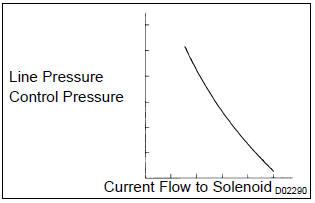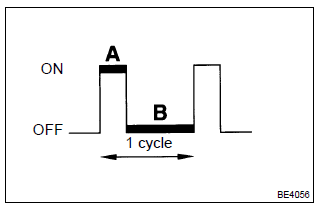Toyota Corolla (E120): Circuit description

The throttle pressure that is applied to the primary regulator valve (which modulates the line pressure) causes the solenoid valve slt, under electronic control, to precisely and minutely modulate and generate the line pressure according the extent of the accelerator pedal depressed or the output of engine power.
This controls the line pressure and provides smooth shifting.
Upon receiving a signal of the throttle valve opening angle, the ecm controls the line pressure by sending a predetermined (*) duty ratio to the solenoid valve, modulating the line pressure and generating throttle pressure.
(*): Duty ratio the duty ratio is the ratio of the period of continuity in one cycle.
For example, if a is the period of continuity in one cycle, and b is the period of non–continuity, then duty ratio=a/(a+b) x 100 (%)


Monitor description
The linear solenoid valve (slt) controls the transmission line pressure for smooth transmission operation based on signals from the throttle position sensor and the vehicle speed sensor. The ecm adjusts the duty cycle of the slt solenoid valve to control hydraulic line pressure coming from the primary regulator valve.
Appropriate line pressure assures smooth shifting with varying engine outputs. When an open or short in the linear solenoid valve (slt) circuit is detected, the ecm interprets this as a fault. The ecm will turn on the mil.
Monitor strategy

Typical enabling condition

Typical malfunction thresholds

Component operating range

Wiring diagram

Other materials:
Circuit description
When the idle switch is turned on, a signal is sent to the cruise control ecu
assy. The cruise control ecu
assy uses this signal to correct the discrepancy between the throttle valve
position and the actuator position
sensor values to enable accurate cruise control at the set speed. If the idl ...
Inspection procedure
1 Check side squib(rh) circuit(airbag sensor assy center – front
seat airbag assy rh)
Disconnect the negative (–) terminal cable from the battery,
and wait at least for 90 seconds.
disconnect the connectors between the airbag sensor
assy center and the front seat airbag assy ...
Replacement
Hint:
installation is in the reverse order of the removal. But the installation is
indicated only when it has a point.
1. Remove radiator grille sub–assy
Remove the 2 bolts and clip.
using a screwdriver, remove the radiator grille.
Hint:
tape the screwdriver tip before use. ...


